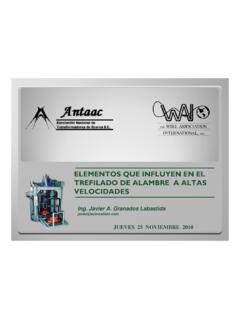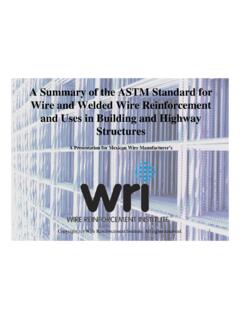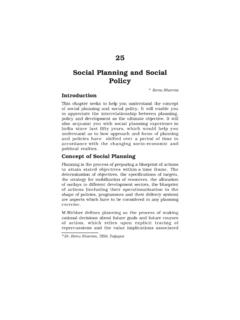Transcription of THEORY OF WIREDRAWING - ANTAAC
1 THEORY OF WIREDRAWING . Introduction Prior to the adoption of continuous drawing practices, little atten- tion was given to understanding WIREDRAWING THEORY . This can be largely attributed to the fact that, until the introduction of steam power, the single, largest problem facing wiredrawers was obtaining the necessary motive force required for the drawing process. As developments and improvements in mechanization developed dur- ing the Industrial Revolution, little emphasis was placed on under- standing the physical process, as satisfactory results were generally obtainable with the moderate drawing speeds and drafting that were used. In any event, wire could be processed only in low volume as short die life limited any further increases in productivity and quali- ty. However, commercial introduction of cemented carbide dies in Germany during the 1920s resulted in an increase in drawing speeds and sophistication in wire mills to handle the larger volumes that could be drawn.
2 Therefore, it was soon apparent that a more detailed understanding of the WIREDRAWING process was needed. While an impressive body of knowledge has accumulated that affords a comprehensive picture of single-hole WIREDRAWING , addi- tional detail is needed, particularly for multi-hole processes. Modern WIREDRAWING is a highly competitive global business where product requirements are continuously changing and the traditional evolu- tionary or Edisonian techniques, which characterized technology development in the past, are no longer viable. Furthermore, given the limited resources that are available in the industry as well as the rapidly changing technical requirements, it is clear that personnel at all levels need an in-depth understanding of WIREDRAWING THEORY . It is 1. also clear that such an understanding is a prerequisite for controlling and optimizing existing processes and the sustainable development of new technology.
3 Mechanics of WIREDRAWING Deformation in WIREDRAWING is influenced by a number of factors;. wire chemistry, approach angle, lubrication, drawing speed, and reduction are the most significant. The primary emphasis in wire- drawing mechanics is on understanding and defining the relation- ships that exist between these process conditions and the resulting thermo-mechanical response of the wire. Many of the technological developments that have taken place in WIREDRAWING over the past 20. years have been the result of an increased understanding of these relationships. Constancy of Volume Although the fact that volume is not lost during deformation may seem obvious, it is, in fact, a highly useful concept that forms the basis for analyzing a number of WIREDRAWING problems. One of the most common applications involves the determination of wire speed at different stands and the necessary capstan speeds that should be used.
4 Simply stated, constancy of volume states that the volumetric rate of wire entering a die must be the same as that exiting. Because the cross-sectional area is reduced during drawing, it is necessary that a wire must increase in speed for the same volumetric rate of materi- al to enter and exit the die. Volumetric rate is defined as the cross- sectional area of the wire multiplied by the wire velocity. This can be expressed mathematically as: Eq. (1). where Vi and Vf represent the wire velocities (feet or meters per minute) and di and df are the wire diameters (inches or millimeters). entering and exiting the die, respectively. For circular wire, Equation 1 can be simplified and reduced to: Eq. (2). 2. In multi-pass drawing, wire speed exiting each die must increase so that the volumetric rate of metal flow is equal at all dies.
5 Therefore, capstans, having an angular velocity equal to the exiting wire speed, are used to pull the wire through the die after each reduc- tion. If this is not done, the wire will break due to unequal wire ten- sion between dies. Because the volumetric rate must be the same at all points, wire velocity can be calculated at any intermediate stand once the incoming wire speed at the first stand is known. As an example, consider a ( mm) wire paid off from a spool at 1,200 feet per minute and reduced to in. ( mm) by using two passes. The velocity of the wire as it exits the last die can then be calculated by using Equation 2a as follows: Eq. (2a). Wire diameter increases as drawing dies wear in actual produc- tion; therefore, based on constancy of volume, wire speed will decrease as the dies increase in size. If the linear speed of the pulling capstan is matched to the wire size of a new die, capstan speed will be faster than the wire speed as the wire diameter increases.
6 This increased capstan speed will apply high tensile stress on the wire, often breaking the wire. Therefore, capstans in multi-pass drawing machines are designed so that the wire slips on the capstan as the dies wear and the wire speed decreases (see Chapter 13). Slip is facilitat- ed by limiting the number of wraps around the pulling capstan and wetting the wire and capstan surfaces with drawing lubricant. Forces and Energy in WIREDRAWING Although it may seem that the forces and power in WIREDRAWING could be analyzed by using simple tension, deformation conditions in wire are, in fact, far more complex due to compressive and drag forces generated by the die surface. A free body diagram of the forces acting on a wire is shown in Figure 1. Draw force, F, represents the total force that must be applied at the die block to overcome friction at the die surface and resistance of the deforming material.
7 Because the draw force is being transmitted by unsupported material, the draw force must be limited to prevent any plastic deformation from occurring outside of the die. Thus, yield stress of the drawn wire rep- 3. resents an upper limit to the allowable draw stress. Accepted draw- ing practice normally limits draw stress to 60% of the yield strength of the drawn wire. Draw stress is found by dividing the draw force by the cross-sectional area of the drawn wire. Fig. 1. Free body diagram showing the primary forces operating in WIREDRAWING . While it would appear that the work or energy consumed at a given draw stand is dictated by the material and reduction taken, the actual amount needed is considerably higher in practice. This is the result of inefficiencies that exist during deformation, which are pri- marily governed by the approach angle.
8 Such inefficiencies do not make any useful contributions in reducing the cross-sectional area and generally serve only to increase energy requirements and adversely influence wire quality. The total work consumed at a draw stand can be partitioned into three components (see Fig. 2). These are: (a) useful (homogeneous) work required to reduce the cross sec- tion, (b) work required to overcome frictional resistance, and (c). redundant (inhomogeneous) work required to change the flow direc- tion (see Fig. 3). Homogeneous work is determined by drafting (reduction), and is essentially independent of the approach angle. Friction and redundant work, on the other hand, are closely coupled to die geometry and have an opposite effect as the approach angle is changed. Under normal drawing conditions, typical losses are on the order of 20% for frictional work and 12% for redundant 4.
9 Fig. 2. Components of work that operate during WIREDRAWING . Fig. 3. Illustration of (a) homogeneous, (b) frictional, and (c) redundant work in WIREDRAWING . 5. Redundant work and frictional work have adverse effects on wire properties in addition to increasing the energy needed for drawing. One consequence is that mechanical properties will not be homoge- neous across the wire cross section. Because redundant and friction- al deformations are concentrated near the wire surface, higher levels of strain hardening will result in the surface and near-surface layers (analogous to temper rolling) and will be greater than the strain that results from cross section reduction. This strain gradient can be ver- ified easily by performing a hardness survey on a transverse section of cold drawn wire. Also, redundant deformation has an adverse effect on ductility, and this is clearly shown by Caddell and Their results showed that equal yield strengths were obtained at far lower strains for drawn stainless steel rod than for rod deformed in uniaxial tension.
10 For example, to achieve yield strength of approxi- mately 90 ksi (620 MPa), a rod only needed to be drawn to a true strain of , whereas the same material stretched in uniaxial ten- sion required a true strain of Ductility is inversely related to strain; therefore, redundant defor- mation also acts to limit the number of passes and maximum reduc- tion that can be taken prior to Even if this does not lead to problems in drawing, the resultant loss in ductility can lead to frac- turing in subsequent forming processes such as bending and cold heading. Effect of Friction Layers at the wire surface will not only undergo a change in cross section, but they will also deform in shear because of drag presented by the die surface (see Fig. 3b). Even for highly polished die surfaces and hydrodynamic lubrication, a certain amount of frictional work will be present.






